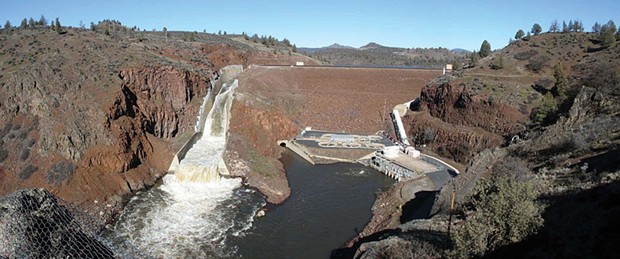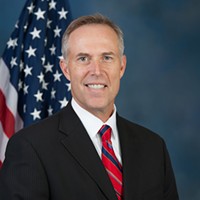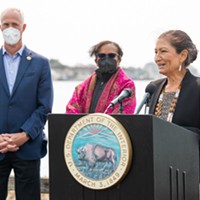Thursday, November 17, 2022
Feds OK Klamath Dam Removal
Posted By Thadeus Greenson @ThadeusGreenson on Thu, Nov 17, 2022 at 2:27 PM
The Federal Regulatory Commission gave its final nod of approval this morning to plans to remove four hydroelectric dams from the Klamath River, putting the largest dam demolition project in U.S. history on track to begin next year.
The vote was unanimous.
“This moment is bigger than anyone could comprehend,” said Amy Cordalis, a Yurok tribal member and the tribe’s former general counsel, in a video recorded after the commission hearing and posted to Twitter. “For so long, our ancestors have fought for this moment. For so long, our families on the river have sacrificed. We’ve lost fish, we’ve lost people, we’ve cried, we’ve fought, and yet here we are in this historic moment where the world is rallying behind us and acknowledging our pain and saying, ‘No more.’ So now, we can transition to welcoming the salmon home, to preparing the river to accept those fish, and that’s how it should be.
That’s an exercise of who we are as Indigenous people of the Klamath River.”
Before the commission voted to approve a license surrender from the dams’ owner, PacifiCorp, to the states of California and Oregon and the nonprofit Klamath River Renewal Corporation, which will oversee removal, Commissioner Allison Clements noted the vote was the culmination of two decades of work from those involved, most notably several tribes.
“I recognize that the decision to remove hydropower project dams affects many people, and that this approval is not without opposition,” she said. “However, the record reflects overwhelming support for removal. I am convinced that the important environmental, cultural and economic benefits that will be realized make removal in the public interest.”
After the vote, North Coast Congressmember Jared Huffman issued a press release praising FERC’s ruling, saying the coming dam removal will help improve poor water conditions that have caused significant harm to fish populations and the tribes that depend on them.
“We know other dam removal projects in the West have seen dramatic beneficial responses for fisheries and wildlife, and the Klamath River has tremendous potential to recover and rebuild as this work is done,” Huffman said. “Congratulations to all of those who have worked to right this wrong and restore balance to the river.”
In a joint press release issued with environmental groups, tribal leaders celebrated the decision as the culmination of decades of work from many.
“The Klamath salmon are coming home,” proclaimed Yurok Chair Joseph James. “The people have earned this victory and with it, we carry on our sacred duty to the fish that have sustained our people since the beginning of time.”
Karuk Tribal Chair Russell ‘Buster’ Attebery said it was a victory “well earned” by the thousands who fought for the river.
Klamath Justice Coalition co-founder Molli Myers noted FERCs decision comes 20 years after a catastrophic fish kill left more than 70,000 salmon dead on the banks of the river, which motivated tribal members and environmental groups to push for dam removal.
“After the 2002 Fish Kill, we committed ourselves to defending our river and our cultures no matter what it would take,” Myers said. “That kind of extraordinary commitment by ordinary Indians is what led to this victory.”
Read the full press releases copied below:
The vote was unanimous.
“This moment is bigger than anyone could comprehend,” said Amy Cordalis, a Yurok tribal member and the tribe’s former general counsel, in a video recorded after the commission hearing and posted to Twitter. “For so long, our ancestors have fought for this moment. For so long, our families on the river have sacrificed. We’ve lost fish, we’ve lost people, we’ve cried, we’ve fought, and yet here we are in this historic moment where the world is rallying behind us and acknowledging our pain and saying, ‘No more.’ So now, we can transition to welcoming the salmon home, to preparing the river to accept those fish, and that’s how it should be.
That’s an exercise of who we are as Indigenous people of the Klamath River.”
Before the commission voted to approve a license surrender from the dams’ owner, PacifiCorp, to the states of California and Oregon and the nonprofit Klamath River Renewal Corporation, which will oversee removal, Commissioner Allison Clements noted the vote was the culmination of two decades of work from those involved, most notably several tribes.
“I recognize that the decision to remove hydropower project dams affects many people, and that this approval is not without opposition,” she said. “However, the record reflects overwhelming support for removal. I am convinced that the important environmental, cultural and economic benefits that will be realized make removal in the public interest.”
After the vote, North Coast Congressmember Jared Huffman issued a press release praising FERC’s ruling, saying the coming dam removal will help improve poor water conditions that have caused significant harm to fish populations and the tribes that depend on them.
“We know other dam removal projects in the West have seen dramatic beneficial responses for fisheries and wildlife, and the Klamath River has tremendous potential to recover and rebuild as this work is done,” Huffman said. “Congratulations to all of those who have worked to right this wrong and restore balance to the river.”
In a joint press release issued with environmental groups, tribal leaders celebrated the decision as the culmination of decades of work from many.
“The Klamath salmon are coming home,” proclaimed Yurok Chair Joseph James. “The people have earned this victory and with it, we carry on our sacred duty to the fish that have sustained our people since the beginning of time.”
Karuk Tribal Chair Russell ‘Buster’ Attebery said it was a victory “well earned” by the thousands who fought for the river.
Klamath Justice Coalition co-founder Molli Myers noted FERCs decision comes 20 years after a catastrophic fish kill left more than 70,000 salmon dead on the banks of the river, which motivated tribal members and environmental groups to push for dam removal.
“After the 2002 Fish Kill, we committed ourselves to defending our river and our cultures no matter what it would take,” Myers said. “That kind of extraordinary commitment by ordinary Indians is what led to this victory.”
Read the full press releases copied below:
FEDERAL REGULATORS GREEN LIGHT LARGEST RIVER RESTORATION PROJECT IN US HISTORY
Removal of Four Klamath River Dams to Begin in 2023
Washington, DC – Today the Federal Energy Regulatory Commission issued a License Surrender Order for the Lower Klamath River Hydroelectric Project. This clears the last major hurdle necessary to implement the world’s largest river restoration project – removal of the lower four Klamath River dams. With this order in place, the Klamath River Renewal Corporation, the non-profit entity created to oversee Klamath River dam removal and related restoration activities, and the States of Oregon and California can accept transfer of the Lower Klamath Project License from energy company PacifiCorp and start the dam removal process early next year.
“The Klamath salmon are coming home,” proclaimed Yurok Chairman Joseph James. “The people have earned this victory and with it, we carry on our sacred duty to the fish that have sustained our people since the beginning of time.”
The dam removal and river restoration project was made possible through a negotiated agreement between Karuk Tribe, Yurok Tribe, California, Oregon, conservation organizations, commercial fishing organizations, and dam owner PacifiCorp, a subsidiary of Warren Buffet’s Berkshire Hathaway Energy. Today’s action by FERC is the last step in a six-year FERC regulatory oversight process that ensures dam removal is the most beneficial course of action to restore the Klamath River’s flagging salmon runs and improve poor water quality.
“Today’s victory was well earned by the thousands of people who fought for clean water, healthy fisheries, and environmental justice for Klamath River communities,” said Karuk Chairman Russell ‘Buster’ Attebery. “I am grateful to everyone, from the youth to the elders, Governors Newsom and Brown, and the team from PacifiCorp who made this victory possible.”
"Congratulations to all those who poured their blood, sweat and tears into making this happen. Water and fish health are at the heart of our identity as Native People and we are looking forward to seeing a healthier watershed and fishery which will result in healthier communities for all Klamath Basin tribes,” said Hoopa Valley Tribe Chairman Joe Davis. “Now we must keep the momentum going and we are looking forward to working with all of our neighbors and partners in that effort."
Commercial salmon fishing families along the West Coast are also celebrating. “Restoring the Klamath gives our struggling salmon fishing industry a chance to survive,” said Vivian Hilliwell, a former commercial salmon harvester and now the Watershed Conservation Director for the Pacific Coast Federation of Fishermen’s Associations (PCFFA). “The possibility of revitalized Klamath fish runs gives us hope that we can continue our tradition of bringing healthy wild salmon to dinner tables across America.”
Dam removal activities are expected to begin in 2023 and be completed in 2024. Personnel and equipment will be deployed in early 2023 to commence pre-removal construction, including road and bridge improvements. Copco 2 dam will be removed first, and deconstruction of the remaining three dams will occur essentially at the same time in early 2024. All four dams will be removed by the end of 2024.
Upstream of the dams, the Klamath Tribes of Oregon are anxious to see salmon return. “Our people have been without c’iyaals (salmon) for over a century. We welcome the fish home to the Upper Klamath Basin with open arms,” said Klamath Tribes Chairman Clayton Dumont.
In issuing the Final License Surrender Order, FERC Commission Chairman Richard Glick stated, “Dam removal makes sense in large part due to fish and wildlife protections. But there is a discussion in the order on the impact on Tribes and the ability to have their traditions and cultural practices improved... I think it’s a very important issue. A number of years back the commission did not think about the impact of our decisions on Tribes. That’s an important element in today’s order…”
The decision comes almost exactly 20 years after a catastrophic fish kill left over 70,000 adult salmon dead along the banks of the Klamath River before they could spawn. That disaster galvanized the collective will of Klamath River Tribes, community members, fishermen, conservationists, and others who launched a two-decades-long effort to un-dam the Klamath and Bring the Salmon Home.
“After the 2002 Fish Kill we committed ourselves to defending our river and our cultures no matter what it would take,” said Molli Myers, co-founder of the Klamath Justice Coalition and member of the Karuk Tribe. “That kind of extraordinary commitment by ordinary Indians is what led to this victory.”
Today’s Klamath River salmon returns are less than 5% of their historical abundance with some runs of salmon completely extirpated from the system. Dams deny salmon access to hundreds of miles of historical habitat, degrade water quality, and foster the spread of fish diseases. Scientific studies and dam removal efforts in other watersheds demonstrate that dam removal can reverse these trends.
“This is a historic day for the Tribes of the Klamath River and for Indigenous People all over the world. When we act together with a unified voice no power in this universe can stop us,” said Ridges to Riffles Indigenous Conservation Group Principal and Yurok Tribal member Amy Cordalis.
Representatives from additional organizations that advocated for Klamath dam removal also commented on today’s significant action by FERC.
"Restoring the Klamath River is a historic win for people, salmon, and everything that depends on a clean, healthy river. It demonstrates the power of persistence and collaboration. When people come together around a vision for their river, it really is possible to change the world." – Brian Graber, Senior Director of River Restoration, American Rivers
“Dam removal represents a monumental achievement. As we look beyond this historic moment, Sustainable Northwest will continue partnering in the Klamath basin to build on this success to improve water quality and meet water demands that support Tribes, farmers, ranchers, and native wildlife.” – Greg Block, President, Sustainable Northwest
"I inherited the responsibility to take care of my relatives, the salmon, from my father. While I have spent most of my life as an activist at protests and rallies, my hope is for my children to spend more time fishing and less time protesting.” - Save California Salmon Education Director Charley Reed, who was seven years old when with the Klamath fish kill set the Bring the Salmon Home movement in motion.
“It feels like a lifetime ago that we started working on this momentous effort together. It became clear early on in our efforts to protect and restore the wild Spring Chinook of the Salmon River that the Klamath dams would have to come down in order to realize that dream. With partners around the basin, we have been working towards that goal for over 20 years and now, finally, we’re going to take down the Iron Gate Dam and let those fish run through!” - Petey Brucker, Salmon River Restoration Council’s co-founder who was involved in dam removal negotiations from their inception.
“The Klamath River has been Exhibit A for how dams, drought, imbalanced water management and climate change can strangle a river. Now, the Klamath is poised to become a prime example of how an entire river system, and the people and wildlife that depend on it, can be renewed. The major investments TU and others have made in improving water quality, fish passage and habitat in the upper Klamath Basin will soon pay their full dividends, as salmon and steelhead finally come back to their ancestral spawning grounds. We salute the Tribal, state, and federal leaders who have helped make this happen, and PacifiCorp and the KRRC for their commitment to bringing the Klamath back to life.” – Chrysten Rivard, Director, Trout Unlimited’s Oregon Program
“The removal of these dams begins the Klamath’s recovery from a century of dam-related impacts. We look forward to the many ways that people will experience the renewed Klamath, including the 41 miles of new whitewater river that will emerge when the dams come down.” – Thomas O’Keefe, Pacific Northwest Stewardship Director, American Whitewater
“It’s been incredible for CalTrout to join forces with over 40 organizations and Native American Tribes in support of taking the Klamath dams out. Tribal leadership has been a central component of this effort. The Yurok, Karuk and Klamath River Tribes have led the effort to restore part of their cultural heritage and subsistence fishing for salmon and lamprey. With the Klamath River being the second largest river in California, it represents a huge opportunity to achieve native wild salmon and steelhead abundance in a way that we haven’t seen for many decades.” – Curtis Knight, Executive Director of California Trout
# # #
Rep. Huffman Praises FERC Decision to Clear the Way for Klamath Dam Removal
Washington, D.C. – Congressman Jared Huffman (D-San Rafael) applauded the Federal Energy Regulatory Commission’s (FERC) decision today to issue a license surrender order that clears the way for removal of four Klamath River dams and the largest river restoration effort in history.
“FERC’s decision to retire PacifiCorp’s dams is the result of years of difficult work by our dedicated North Coast tribes, conservationists, the leadership of California and Oregon, and members of Congress,” said Rep Huffman. “Poor conditions on the Klamath River have caused substantial harm to tribal communities, commercial and sport fishermen, and the economies of California and Oregon. We know other dam removal projects in the West have seen dramatic beneficial responses for fisheries and wildlife, and the Klamath River has tremendous potential to recover and rebuild as this work is done. Congratulations to all of those who have worked to right this wrong and restore balance to the river.”
The order allows the Klamath River Renewal Corporation – a non-profit group that will lead the dam removal effort – and the states of California and Oregon to take over PacifiCorp’s license for the purpose of demolishing the dams. Construction crews will begin preparing the area for dam removal in early 2023 and will remove the Copco 2 dam next year. The remaining dams will be removed all in 2024.
The dams have for decades blocked salmon from reaching hundreds of miles of productive salmon habitat. The shallow reservoirs regularly become choked with toxic algae and cause elevated temperatures downstream. Impaired flows have led to an abundance of disease that often kills most young salmon in the river. Removal of the dams is expected to vastly improve water quality, reduce the presence of fish disease, and reopen vital spawning habitat.
Rep. Huffman has been an active partner in the efforts to remove the Klamath River dams. Following signs in July 2020 that PacifiCorp may walk back its commitment to dam removal, Rep. Huffman, Chair of the House Natural Resources Subcommittee on Water, Oceans, and Wildlife, held a public forum to examine the terrible impacts the dams have had on salmon and downstream water quality. In September of that year, he successfully offered an amendment to the Clean Economy Jobs and Innovation Act, which was approved by the House, to safeguard Tribal communities against further harm to the Klamath River and its ecosystem caused by PacifiCorp’s delays.
###
Speaking of...
Readers also liked…
more from the author
-
Huffman on Thursday Night Talk: Harris is Dems' Best Chance at Presidency
- Jul 18, 2024
-
The Crises of Our Time
- Jul 18, 2024
-
Huffman Talks Project 2025
With his task force in the thick of the campaign, North Coast rep says policy blueprint raises stakes of presidential race
- Jul 18, 2024
- More »



































